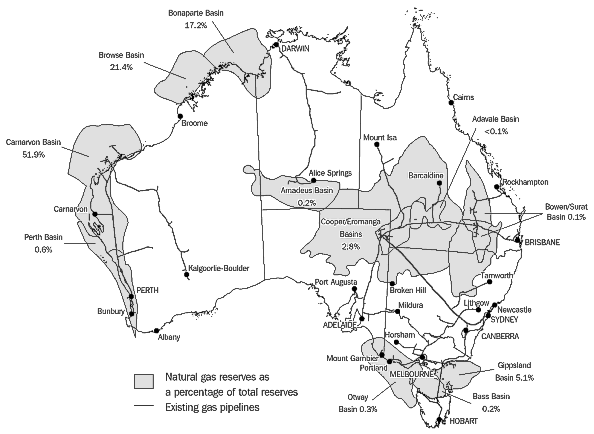|
|
ENERGY RESOURCES
Australia has large resources of fossil fuels and uranium. It is ranked in the top six countries in the world for economic demonstrated resources (EDR) of black and brown coal, and has the world's largest EDR of uranium (Geoscience Australia 2003). Australia also has significant reserves of natural gas and crude oil. For a more detailed outline on Australia's energy and mineral resources, see the Mining chapter.
Australia has substantial resources of high quality black coal. Most of these resources are located in New South Wales and Queensland. Small but locally important coal resources occur in Western Australia, South Australia and Tasmania. Brown coal occurs mainly in Victoria with other deposits in Western Australia, South Australia and Tasmania (Geoscience Australia 2003).
Map 17.2 shows the extent of access to gas resources and major transmission pipelines in Australia. At June 2003, EDR of natural gas totalled 101,120 PJ, with the Carnarvon Basin accounting for over 50% of total reserves (Geoscience Australia 2005). The total length of Australia's transmission pipeline system has increased from 9,000 kilometres (km) in 1989 to over 20,000 km in 2001 (APIA 2001).
17.2 GAS RESERVES AND PIPELINES - July 2002

Source: The Australian Gas Association.
Between 1993 and 2003 the EDR of black coal, brown coal, and crude oil have decreased, while the EDR of liquified petroleum gas (LPG), condensate, natural gas and uranium have increased in the same period (table 17.3). Changes in EDRs can be due to production activity and discoveries and reclassification of resources due to reassessments (such as with black and brown coal in 1999, when some resources previously considered economic were reclassified as subeconomic).
17.3 ECONOMIC DEMONSTRATED RESOURCES OF PRIMARY ENERGY PRODUCTS(a) - 30 June
|
 | 1993 | 2003 | Change from 1993 to 2003 |
| Fuel | PJ | PJ | % |
|
| Black coal | 1,333,800 | 1,071,900 | -19.6 |
| Brown coal | 400,610 | 364,720 | -9.0 |
| Crude oil | 9,213 | 6,512 | -29.3 |
| Condensate | 4,588 | 10,249 | 123.4 |
| LPG | 3,472 | 7,261 | 109.2 |
| Natural gas | 38,000 | 101,120 | 166.1 |
| Uranium | 296,570 | 323,830 | 9.2 |
|
(a) Non-renewable resources only.
Source: Australian System of National Accounts (5204.0). |
The net present value (NPV) of an energy resource is the expected value of the resource based on current market value, with some modifications based on depletion and economic forces. At June 2003, the NPV of Australian energy and mineral resources was $245 billion (b) (table 17.4). The two most significant energy resources were black coal and natural gas, accounting for 36% and 37% of the total NPV of energy resources respectively. The increase in the value of energy resources between 1993 and 2003 was primarily due to increases in the NPV of black coal and natural gas over this period - the NPV of black coal alone increased more than ten-fold.
17.4 NET PRESENT VALUE OF PRIMARY ENERGY RESOURCES - 30 June
|
 | 1993 | 2003 | Change from 1993 to 2003 |
| Fuel | $m | $m | % |
|
| Black coal | 7,942 | 88,386 | 1,012.9 |
| Brown coal | 280 | 1,308 | 270.7 |
| Crude oil | 15,491 | 26,667 | 72.1 |
| Condensate | 3,119 | 22,868 | 633.2 |
| LPG(a) | 891 | 11,205 | 1,157.6 |
| Natural gas | 18,114 | 90,169 | 397.8 |
| Uranium | 1,909 | 4,727 | 147.6 |
| Total | 47,746 | 245,330 | 413.8 |
|
(a) Naturally occurring.
Source: Australian System of National Accounts (5204.0). |
|
 Print Page
Print Page